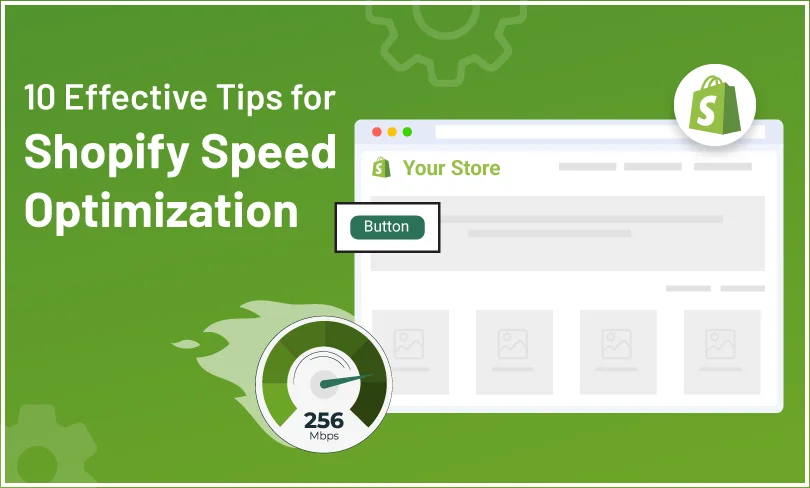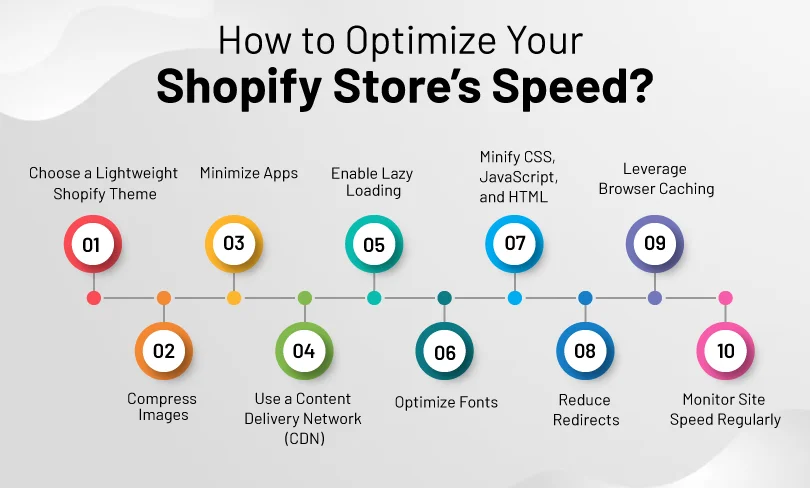10 Effective Tips for Shopify Speed Optimization

In the competitive world of eCommerce, the speed of your Shopify store is crucial. A slow site can turn away potential customers, leading to lost sales. But don’t worry, Shopify Speed Optimization is easier than you think!
This blog will explore 10 simple yet effective tips to boost your store’s performance. From selecting the right theme to optimizing images and minimizing app usage, these tips are designed to enhance user experience and improve your search engine rankings. Let’s get started on making your Shopify store faster and more efficient!
What effect does a slow website have on your Shopify store?
A slow website can significantly impact your Shopify store’s performance and success. First, it leads to poor user experience, causing visitors to leave out of frustration. Studies show that even a one-second delay can reduce customer satisfaction by 16%, resulting in higher bounce rates. This can lead to fewer conversions and lost sales opportunities.
Additionally, search engines like Google prioritize fast-loading websites in search rankings. A slow site can negatively affect your SEO performance, making it harder for potential customers to find you.
Overall, a sluggish website can damage your brand’s credibility, reduce customer retention, and harm your bottom line, making speed optimization critical for your Shopify store’s success.
How to Optimize Your Shopify Store’s Speed?

Ensuring your Shopify store loads quickly is essential for keeping customers happy and boosting sales. Slow websites can frustrate visitors and lead to lost revenue. Here are 10 tips for Shopify Speed Optimization, with insights from Shopify Experts:
1. Choose a Lightweight Shopify Theme
Select a theme built for speed. Lightweight themes with clean code and minimal animations ensure faster loading times. Avoid themes with excessive features and heavy design elements that slow down your store’s performance.
2. Compress Images
High-resolution images can slow down your site, but compressing them reduces file size without losing quality. Use Shopify apps like TinyIMG or Crush.pics to compress your images and maintain fast loading speeds automatically.
3. Minimize Apps
Each app you install adds extra code to your store, which can slow down performance. Review your apps regularly and remove those that are unnecessary or underperforming. Limiting the number of active apps ensures your store runs smoothly.
4. Enable Lazy Loading
Lazy loading allows off-screen images to load only when they come into view, reducing the amount of data loaded initially. This results in a faster first-page load, keeping users engaged longer and improving the overall experience.
5. Use a Content Delivery Network (CDN)
A CDN helps to load your website faster by distributing content across multiple servers globally. Shopify has a built-in CDN, but optimizing it further ensures that users, no matter where they are located, can access your store quickly.
6. Optimize Fonts
Custom fonts can slow down your site. Use system fonts or web-safe fonts when possible, and if you must use custom fonts, make sure they are optimized for speed. Reducing the number of font variations and weights also helps minimize load times.
7. Minify CSS, JavaScript, and HTML
Minifying code removes unnecessary characters like spaces and comments from your CSS, JavaScript, and HTML files. This reduces their size and improves loading speed without affecting functionality or design. Tools like Asset CleanUp can help you manage this.
8. Reduce Redirects
Excessive redirects create additional server requests, which slow down your site. Audit your site for unnecessary redirects and broken links, and try to minimize them to ensure quicker page loads and better user experience.
9. Leverage Browser Caching
Browser caching allows users’ browsers to store commonly accessed files, such as images and stylesheets, locally on their devices. This means that returning visitors experience faster load times since their browsers don’t need to download these elements repeatedly.
10. Monitor Site Speed Regularly
Speed optimization isn’t a one-time task. Use tools like Google PageSpeed Insights, GTmetrix, or Pingdom to regularly check your site’s speed and performance. Regular monitoring helps identify and address any new issues before they impact your store’s performance.
Why does Shopify speed matter?
Shopify speed plays a crucial role in the success of your online store. A fast-loading website not only provides a better user experience but also encourages customers to stay longer and make purchases. Studies show that even a one-second delay in load time can reduce conversions by up to 7%.
Additionally, site speed directly affects your search engine rankings, as Google prioritizes fast websites. Poor performance can lead to higher bounce rates and lower visibility, impacting your sales.
Effective Shopify Speed Optimization ensures smoother navigation, faster checkouts, and higher customer satisfaction, ultimately leading to increased revenue and stronger brand credibility. A faster site means a better-performing business.
Conclusion
In today’s fast-paced digital world, every second counts, especially for your Shopify store. Implementing these 10 effective tips for Shopify speed optimization can significantly enhance your site’s performance, improve user experience, and boost your conversion rates. A well-optimized store keeps customers engaged, reduces bounce rates, and helps improve your search engine rankings.
However, speed optimization can be complex and time-consuming, so you can opt for a Shopify Development Company to ensure your store is fully optimized without compromising on design or functionality. With expert support, you can focus on growing your business while leaving the technical aspects of speed optimization in capable hands.
 Back to blog
Back to blog 


